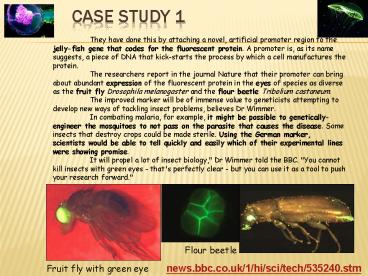Case study 1 - PowerPoint PPT Presentation
Title:
Case study 1
Description:
... can bring about abundant expression of the fluorescent protein in the eyes of species as diverse as the fruit fly Drosophila melanogaster ... Insulin moves it out ... – PowerPoint PPT presentation
Number of Views:50
Avg rating:3.0/5.0
Title: Case study 1
1
Case study 1
They have done this by attaching a novel,
artificial promoter region to the jelly-fish gene
that codes for the fluorescent protein. A
promoter is, as its name suggests, a piece of DNA
that kick-starts the process by which a cell
manufactures the protein. The researchers
report in the journal Nature that their promoter
can bring about abundant expression of the
fluorescent protein in the eyes of species as
diverse as the fruit fly Drosophila melanogaster
and the flour beetle Tribolium castaneum. The
improved marker will be of immense value to
geneticists attempting to develop new ways of
tackling insect problems, believes Dr Wimmer.
In combating malaria, for example, it might be
possible to genetically-engineer the mosquitoes
to not pass on the parasite that causes the
disease. Some insects that destroy crops could be
made sterile. Using the German marker, scientists
would be able to tell quickly and easily which of
their experimental lines were showing promise.
It will propel a lot of insect biology," Dr
Wimmer told the BBC. "You cannot kill insects
with green eyes - that's perfectly clear - but
you can use it as a tool to push your research
forward."
Flour beetle
news.bbc.co.uk/1/hi/sci/tech/535240.stm
Fruit fly with green eye
2
Case study 2
Modified hens lay eggs to help beat cancer By
Roger Highfield, Science Editor
Last Updated 1237am GMT 15/01/2007
A flock of designer hens, genetically modified
with human genes to lay eggs capable of producing
drugs that fight cancer and other
life-threatening diseases, has been created by
British scientists. Researchers at the Roslin
Institute near Edinburgh, which created
pioneering GM animal "drug factories" such as
Tracy the sheep as well as Dolly the clone, have
bred a 500-strong flock of ISA Browns. These are
a prolific egg laying French cross between Rhode
Island Red and Rhode Island White chickens. A
transgenic (GM) hen delivers an egg containing
drug therapies at a fraction of normal cost. They
make proteins used as drugs produced in the
whites of their eggs. This makes up 54 of egg
whites, around 2.2g per egg. They offer the
prospect of mass-producing at a fraction of the
price drugs that cost thousands of pounds a year
per patient. This marks an important advance in
the use of farm animals for the production of
pharmaceuticals. They inserted the human genes
into chicken embryonic stem cells, then blended
those cells with those of a normal chicken embryo
to create a chimera, a blend of GM and normal
cells. The genes were passed on to the next
generation. There have been attempts to make
protein drugs in the milk of sheep, goats, cattle
and rabbits, the team believes that the
conversion of chickens into "bioreactors" offers
many advantages. They produce more quickly and
are much cheaper to look after.
http//www.telegraph.co.uk/news/main.jhtml?xml/ne
ws/2007/01/15/nhealth15.xml
3
Case study 3
Insulin
Explain the ever-increasing need for insulin
produced by biotechnology.
4
Living with diabetes
Your body has too much glucose (sugar) in its
blood, a potentially fatal condition. Insulin
moves it out of the blood, into the cells where
it is broken down to produce energy.
Control involves regular checks of blood sugar
before and after meals. Insulin injections (2 -
4x day). In older people it involves diet
changes, weight loss, exercise and often insulin
tablets or injections.
5
Ageing population
- 1971- 55.9 million
- Over 65- 7.4m
- Under 16- 14.2m
8
- 2006- 60.6 million
- Over 65- 9.7m
- Under 16- 11.5m
31
The Issue
- 19
More diabetics They live longer Allergy to animal
sources of insulin
- Over 85s
6
One problem
Diabetes develops in older people when their
pancreatic cells stop making insulin
6
Sources of insulin
Ethical objections Some people allergic More risk
of side effects
Identical to human insulin no side-effects Pure
no allergies Produce large quantities meets ?
demand Quick relatively cheap animals slow,
expensive































